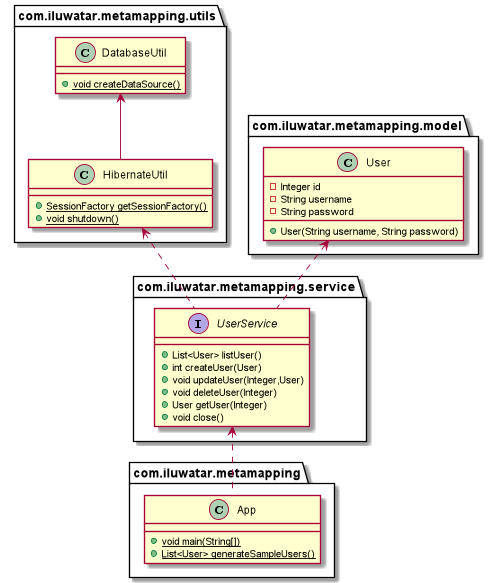Metadata Mapping
- Architectural
Intent
Holds details of object-relational mapping in the metadata.
Explanation
Real world example
Hibernate ORM Tool uses Metadata Mapping Pattern to specify the mapping between classes and tables either using XML or annotations in code.
In plain words
Metadata Mapping specifies the mapping between classes and tables so that we could treat a table of any database like a Java class.
Wikipedia says
Create a "virtual object database" that can be used from within the programming language.
Programmatic Example
We give an example about visiting the information of user_account table in h2 database. Firstly, we create user_account table with h2:
@Slf4j
public class DatabaseUtil {
private static final String DB_URL = "jdbc:h2:mem:metamapping";
private static final String CREATE_SCHEMA_SQL = "DROP TABLE IF EXISTS `user_account`;"
+ "CREATE TABLE `user_account` (\n"
+ " `id` int(11) NOT NULL AUTO_INCREMENT,\n"
+ " `username` varchar(255) NOT NULL,\n"
+ " `password` varchar(255) NOT NULL,\n"
+ " PRIMARY KEY (`id`)\n"
+ ");";
/**
* Create database.
*/
static {
LOGGER.info("create h2 database");
var source = new JdbcDataSource();
source.setURL(DB_URL);
try (var statement = source.getConnection().createStatement()) {
statement.execute(CREATE_SCHEMA_SQL);
} catch (SQLException e) {
LOGGER.error("unable to create h2 data source", e);
}
}
}
Correspondingly, here's the basic User entity.
@Setter
@Getter
@ToString
public class User {
private Integer id;
private String username;
private String password;
/**
* Get a user.
* @param username user name
* @param password user password
*/
public User(String username, String password) {
this.username = username;
this.password = password;
}
}
Then we write a xml file to show the mapping between the table and the object:
<?xml version="1.0" encoding="utf-8"?>
<!DOCTYPE hibernate-mapping PUBLIC
"-//Hibernate/Hibernate Mapping DTD//EN"
"http://www.hibernate.org/dtd/hibernate-mapping-3.0.dtd">
<hibernate-mapping>
<class name="com.iluwatar.metamapping.model.User" table="user_account">
<id name="id" type="java.lang.Integer" column="id">
<generator class="native"/>
</id>
<property name="username" column="username" type="java.lang.String"/>
<property name="password" column="password" type="java.lang.String"/>
</class>
</hibernate-mapping>
We use Hibernate to resolve the mapping and connect to our database, here's its configuration:
<?xml version="1.0" encoding="utf-8"?>
<!DOCTYPE hibernate-configuration PUBLIC
"-//Hibernate/Hibernate Configuration DTD 3.0//EN"
"http://www.hibernate.org/dtd/hibernate-configuration-3.0.dtd">
<hibernate-configuration>
<session-factory>
<!-- JDBC Database connection settings -->
<property name="connection.url">jdbc:h2:mem:metamapping</property>
<property name="connection.driver_class">org.h2.Driver</property>
<!-- JDBC connection pool settings ... using built-in test pool -->
<property name="connection.pool_size">1</property>
<!-- Select our SQL dialect -->
<property name="dialect">org.hibernate.dialect.H2Dialect</property>
<!-- Echo the SQL to stdout -->
<property name="show_sql">false</property>
<!-- Drop and re-create the database schema on startup -->
<property name="hbm2ddl.auto">create-drop</property>
<mapping resource="com/iluwatar/metamapping/model/User.hbm.xml" />
</session-factory>
</hibernate-configuration>
Then we can get access to the table just like an object with Hibernate, here's some CRUDs:
@Slf4j
public class UserService {
private static final SessionFactory factory = HibernateUtil.getSessionFactory();
/**
* List all users.
* @return list of users
*/
public List<User> listUser() {
LOGGER.info("list all users.");
List<User> users = new ArrayList<>();
try (var session = factory.openSession()) {
var tx = session.beginTransaction();
List<User> userIter = session.createQuery("FROM User").list();
for (var iterator = userIter.iterator(); iterator.hasNext();) {
users.add(iterator.next());
}
tx.commit();
} catch (HibernateException e) {
LOGGER.debug("fail to get users", e);
}
return users;
}
// other CRUDs ->
...
public void close() {
HibernateUtil.shutdown();
}
}
Class diagram

Applicability
Use the Metadata Mapping when:
- you want reduce the amount of work needed to handle database mapping.
Known uses
Hibernate, EclipseLink, MyBatis......